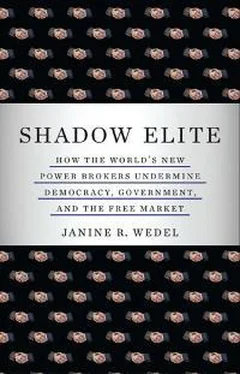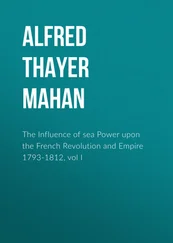And the dearth of memory. Practitioners of truthiness know that the truth of the present moment may not be that of yesterday. Our neoconservative protagonists have mastered this art around the Iraq war, constantly revising history as needed. Thus, for instance, Perle can say with a straight face: “Huge mistakes were made, and I want to be very clear on this: They were not made by neoconservatives, who had almost no voice in what happened. . . .” 110
Mission Accomplished
Perle’s remarks notwithstanding, the extent to which the Neocon core influenced the rush to war is well established. Core members were so intimately enmeshed in advocating, executing, and justifying the war, from so many complementary, interconnected, and influential positions—in government, consultancy, and quasi-governmental posts, NGOs, and media—that it is difficult to imagine the decision to invade Iraq without the involvement of the flex net. To do so, they not only revived, but pressed into full service, their methods from the 1970s, 1980s, and 1990s—including gathering and disseminating alternative intelligence to supplant government processes and findings; manipulating around bureaucratic and legal rules; improvising and obfuscation of roles; working through pressure groups and quasi-governmental positions; and use of might-be-authorized, might-not-be-authorized American envoys, as well as foreign brokers as go-betweens with foreign nations. They thrust themselves to the top of their influence game not only via these practices, but as flexian innovators in personalizing bureaucracy, privatizing (official) information while branding conviction, and revising (official) rules. Their great achievement is perhaps best summarized by the words of Meyrav Wurmser on a program aired by the BBC in 2003. In introducing Wurmser and other neoconservatives, the host called the moment of the fall of Saddam Hussein “a dream that Meyrav Wurmser and her husband David, now at the State Department, had cherished as long as anyone in Washington.” Meyrav responded: “We actually opened a bottle of champagne. This was a moment we waited for, for many, many years. I mean we’ve been working on freedom for Iraq for the past 9 years maybe. My personal feeling was doing an incredibly good deed by pushing this war because, you know . . . people got their freedom out of it.” 111
And Yet, They Still Go On and On . . .
The new administration in the White House is unlikely to change the players’ ways and means of operating, not to mention their long-held beliefs, even if they no longer occupy key government posts. While the exact extent of their influence on the new administration remains to be seen (some neoconservatives see their future more with Democrats than with Republicans, as Jacob Heilbrunn documents), one thing is certain: They will continue to employ their proven modus operandi—to the extent they are able to get away with it. 112
Iraq was only the first stop. Iran, and, to a lesser degree Syria, have long been on the Neocon core’s wish list. 113Members of the core have long advocated “regime change” in Iran via U.S. interference. Their aim is baldly articulated by intellectual neoconservatives such as Norman Podhoretz, who wrote in a 2007 Commentary article: “As an American and as a Jew, I pray with all my heart that he [President George W. Bush] will [bomb Iran].” 114Michael Ledeen, longtime holder of the “Freedom Chair” at the AEI (now Freedom Scholar at the Foundation for the Defense of Democracies, where Perle and Gaffney are advisers and Woolsey is a member of the Leadership Council), has been a steadfast, vocal advocate for regime change. In a forum at the AEI featuring his book The Iranian Time Bomb: The Mullah Zealots’ Quest for Destruction , Ledeen emphasized that the debate should focus on “the nature of the Iranian regime,” not on Iran’s potential acquisition of nuclear weapons. 115
His activities saturated with ambiguity, Ledeen appears to be the Neocon core’s point person on Iran. In 2006 a new Iranian directorate was created inside the Pentagon’s policy shop where the Office of Special Plans had been housed. Three veterans from the earlier office, including Neocon core member Abram Shulsky (who had worked for Perle in Reagan’s Pentagon and headed the OSP), were tapped to advise or staff the new directorate. In leading the charge on Iran, Ledeen has revived brokers with whom he worked in the Iran-Contra affair. He arranged two secret meetings in 2001 and 2003 with Manucher Ghorbanifar, the expatriate Iranian arms dealer, the goal of which was to put U.S. officials in touch with Iranian dissidents, according to Ledeen. Also participating in the meetings was Lawrence A. Franklin, a Pentagon employee who worked in Feith’s Office of the Undersecretary of Defense for Policy, as well as in his Office of Special Plans, and was later convicted of passing classified documents about Iran to Israel via officials of AIPAC (the American Israel Public Affairs Committee), the pro-Israeli lobbying group. The Senate Intelligence Committee investigated these meetings and found, in the words of journalist Laura Rozen, “that the Pentagon meetings with Ghorbanifar were inappropriate, but neither unauthorized nor illegal. Indeed, it found that the meetings had been authorized by Stephen Hadley, and then deputy defense secretary Paul Wolfowitz, among others.” 116

WHAT TO MAKE of the Neocon core? This web of state-private players, of course, does not fit neatly into standard categories. They are clearly much more than an “issue network” or assortment of like-minded activists or pundits. They have never been top-tier official “deciders”: They have exerted influence either from second-tier positions in government or from outside (and working together from these varying venues and posts). Because they are not simply government officials, they are often not within reach of government oversight. They cannot be reduced to lobbyists or interest groups, which operate mostly from outside government, or Wise Men, who serve as in-house advisers. They are not covert or intelligence operatives who, by definition, lie outside the public eye (though aspects of their activities may well be covert). 117
The Neocon core is effective because they practice the modus operandi of a flex net. Bringing coordination to sometimes convoluted government, flex nets can be attractive to an administration and the public. For instance, the perseverance, unity, and modus operandi that has made the Neocon core effective in achieving many of its goals can make it an asset to a president. But these same qualities can also make it a liability, because the group has its own power and interests, which may at times diverge from the president’s or reflect badly on him if the policies turn out to be unpopular.
In fact, it seems, unpopular policies are more likely to reflect badly on the president than they are on themselves. One of the features of flexians is their propensity to skirt not only legal and regulatory rules, but avoid career and reputational damage as well.
Whether the Neocon core is successful in getting its policies implemented or not, its members’ success as personalities seems well established. Once Bush II was reelected in 2004, members of the Neocon core fared well, despite the Iraq debacle. Paul Wolfowitz, deputy defense secretary in the first term, was promoted to be the new president of the World Bank (though he later resigned for “personal reasons”). John Bolton moved to the United Nations, despite the U.S. Congress’s unwillingness to confirm him. Douglas Feith, who announced his resignation as undersecretary of defense for “personal reasons,” continued to work on the Pentagon’s Quadrennial Defense Review (an unprecedented role for nonofficials), joined the faculty at Georgetown University, and later moved to a think tank. 118
Читать дальше













